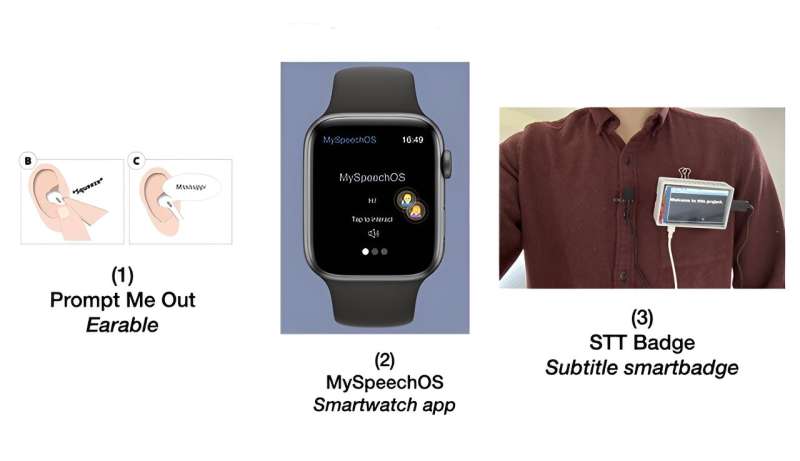This article has been reviewed according to Science X's editorial process and policies. Editors have highlighted the following attributes while ensuring the content's credibility:
fact-checked
trusted source
proofread
Research offers breakthrough in bridging the communication gap for people with language impairments

A team of King's Informatics researchers have developed a series of prototype tools that empower communities with communication impairments to speak up. Co-designed with focus groups of complex communication needs (CCNs) sufferers, the team created wearable augmentative and alternative communication (AAC) prototypes in a first of its kind study, which have the potential to be used alongside traditional therapies.
An AAC device is a piece of technology which helps someone with a speech or language impairment to communicate. For those with CCNs, these impairments can result in difficulties speaking, reading and writing and can be the result of a diverse range of conditions such as dementia and aphasia—a language impairment often caused by stroke.
The lack of easy communication available to those with CCNs can often hinder their ability to build meaningful relationships, potentially resulting in isolation. People living with CCNs are at a significantly greater risk of unemployment, reduced education access, emotional distress, and depression. While speech and language therapies are currently the primary forms of treatment for those living with CCNs, long waiting lists have impacted care for many.
AAC devices can fill this gap and offer vital communication support for those with CCNs, yet traditional devices are rarely adopted and frequently abandoned. These often large, bulky tablet-like devices inhibit vital forms of non-verbal communication like body language and are generally stigmatized because of how visible they are, causing anxiety when faced with social pressures.
However, the team's research also revealed that visible AAC devices can be beneficial for setting clear expectations during conversations with users, and increasing awareness about people's underlying disability.
Humphrey Curtis, Department of Informatics, said, "I believe it's crucial to offer people with aphasia and other invisible disabilities the autonomy to control the visibility of their assistive technology dependent on context and setting. Our partnership with charity Aphasia Re-Connect allowed us to co-design directly with people living with aphasia, and was vital for ensuring the AAC technologies we built empowered people to be more independent."
By a process of qualitative analysis in partnership with focus groups of CCN sufferers, the research team highlighted the importance of creating flexible high-tech AAC interventions that can adapt to the changing communication needs of individuals.
Participants highlighted their need for devices that they could control the visibility of, depending on their specific needs, situation or environment. By implementing a design philosophy that ensured these devices were discreet and invisible, when their users wanted them to be, the research team could side-step traditional issues surrounding social stigma and abandonment.
Embracing a methodology of building with participants rather than for them, the team could also use this changing visibility to empower CCN sufferers to set clear expectations when communicating.
The team ultimately hope as discreet and wearable technologies become more unobtrusive, immersive and intelligent, these 'smart' devices will increasingly be leveraged to support people with disabilities such as CCNs.
The researchers' paper, entitled Envisioning the (In)Visibility of Discreet and Wearable AAC Devices, was awarded a Best Paper Award at the recent ACM Conference on Human Factors in Computing Systems, a conference in the field of human–computer interaction. The work is published as part of the Proceedings of the 2023 CHI Conference on Human Factors in Computing Systems.
More information: Humphrey Curtis et al, Envisioning the (In)Visibility of Discreet and Wearable AAC Devices, Proceedings of the 2023 CHI Conference on Human Factors in Computing Systems (2023). DOI: 10.1145/3544548.3580936


















